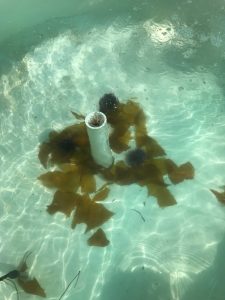Swimming! Freediving! Kayaking! Boat Trips! ….These are all fun activities, especially in the summertime.
Ocean warming. Ocean acidification. Invasive species. ….These are all very bad things. Bad things that are caused almost exclusively by humans. And as humans we really should do our best to leave this world a better place than we found it.
This summer I had the amazing opportunity to be a part of a program that allowed me to do all these awesome activities while assisting with research on these major issues.

I am a student intern at the California Marine Institute Laboratory (CMIL) an SDSU research facility. Here, students, professors, and other scientists conduct research along the coast of southern California. I started with this facility this summer after being selected to participate in an internship program that pairs San Diego Community College District students with SDSU graduate student mentors. The students that I worked most with this summer were my mentor, Masters student Mitch Johnson, and the director of the internship program, PhD candidate Jessica Griffin.
Both of the main projects I helped with this summer, Jesssica’s and Mitch’s projects, study how marine organisms interact and how future conditions from a changed climate might affect them. In Jessica’s experiment, we aimed to study the interactions of seagrass and clams to see how these interactions change under different conditions. We set up a variety of tanks of seawater containing clams, algae cultures, and sea grass. All tanks had seagrass while some tanks had algae, clams, or both.

In Mitch’s project, we aimed to study the predator/prey relationship between spiny lobsters and purple sea urchins. The lobsters and urchins rely on chemical cues to interact.
These cues could be harder for them to interpret in future climate change conditions. We set up an experimental apparatus to subject them to warmed, acidified, and warmed and acidified conditions to monitor the effects it had on their relationships.


Going into this program I really did not know what to expect. I knew that I wanted to be a biologist of some kind but was struggling to decide between majoring in General Biology and Marine Biology. This program showed me what working as a marine biologist would be like and just a couple of weeks in, I had my answer. I knew that this was the right place for me.
One amazing part about this program was being able to learn so many different aspects of marine biology. I got to participate in fieldwork such as collecting seagrass, kayak training, freediving to collect urchins, and boat trips to the local kelp beds to name a few. I also got to see what goes on in a marine biology lab and learn a lot of useful skills such as experiment design, animal care, aquarium maintenance, respirometry, and last but not least, teamwork. The environment at CMIL is amazing and very conducive to learning and gaining experience. Everyone at the lab is always willing to take a moment to explain what they are working on and even let you be a part of it.

It might sound cliché but being a part of this program has really changed my life. It gave me the opportunity to see what a day in the life of a marine biologist is like and talk about ideas with other like-minded individuals. I really feel at home here in this program and I have learned more than I ever thought was possible in a single summer.
I am continuing my work in the lab as an SDSU student intern as part of a biology research credits course. It allows me to get lab credits for my major while continuing to gain experience and connections in the field of marine biology.
I am so grateful to have been able to take part in this amazing summer program and am very excited to continue working and conducting research here at CMIL. For anyone even remotely interested in marine biology I would strongly advocate at least trying to come and check out the California Marine Institute and laboratory. It just might change your life as it did mine.
